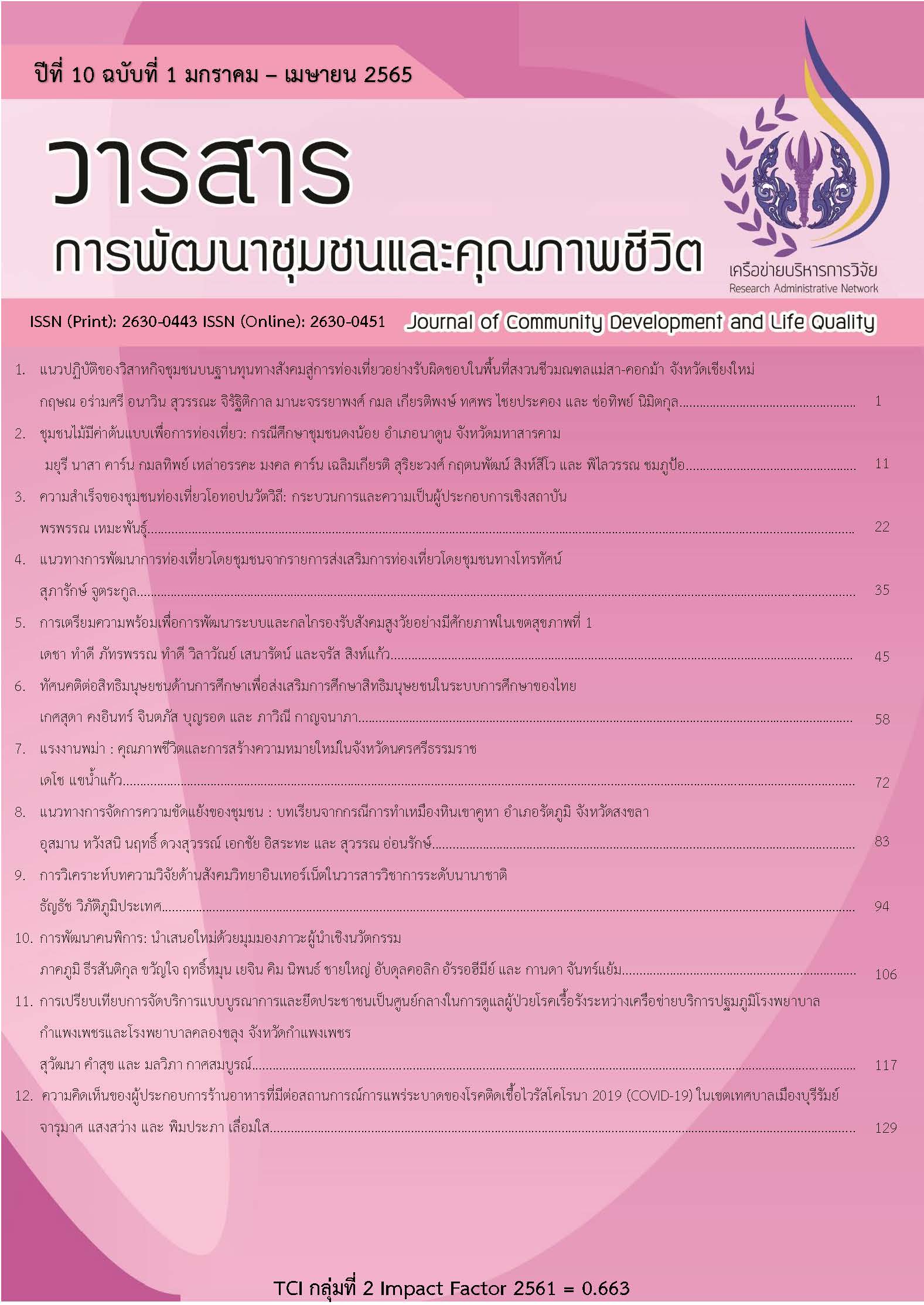การเปรียบเทียบการจัดบริการแบบบูรณาการและยึดประชาชนเป็นศูนย์กลาง ในการดูแลผู้ป่วยโรคเรื้อรังระหว่างเครือข่ายบริการปฐมภูมิโรงพยาบาลกำแพงเพชรและโรงพยาบาลคลองขลุง จังหวัดกำแพงเพชร
Main Article Content
บทคัดย่อ
การศึกษานี้เพื่อประเมินผลการดำเนินการเบื้องต้นในการพัฒนาระบบบริการปฐมภูมิแบบบูรณาการและยึดประชาชนเป็นศูนย์กลางของทีมหมอครอบครัวในจังหวัดกำแพงเพชร โดยระเบียบวิธีวิจัยแบบสำรวจและสัมภาษณ์กึ่งโครงสร้าง กลุ่มตัวอย่างเลือกด้วยวิธีเฉพาะเจาะจงจากสมาชิกทีมหมอครอบครัว จำนวน 33 คน การวิเคราะห์ข้อมูลใช้สถิติ independence t-test และการวิเคราะห์เนื้อหา พบว่า ทีมหมอครอบครัวในจังหวัดกำแพงเพชรมีการดำเนินการพัฒนากระบวนการจัดบริการปฐมภูมิแบบบูรณาการและยึดประชาชนเป็นศูนย์กลางครบทุกองค์ประกอบอยู่ในระดับดีทั้งสองแห่งโดยมีการสร้างปฏิสัมพันธ์ระหว่างทีมหมอครอบครัวและประชาชน และมีการจัดทำแผนดูแลรายบุคคลอย่างมีส่วนร่วมด้วยระบบข้อมูลที่สนับสนุนการบริหารจัดการตนเองทำให้ประชาชนได้รับบริการที่ต่อเนื่องและมีการเชื่อมประสานกัน ผลการวิจัยนี้สามารถใช้เป็นแนวทางในการพัฒนาระบบบริการปฐมภูมิแบบบูรณาการและยึดประชาชนเป็นศูนย์กลางเพื่อการทำงานร่วมกับเครือข่ายที่เกี่ยวข้องในการบริการประชาชนอันนำไปสู่การพัฒนาชุมชนและคุณภาพชีวิต
Article Details

อนุญาตภายใต้เงื่อนไข Creative Commons Attribution-NonCommercial-NoDerivatives 4.0 International License.
กองบรรณาธิการขอสงวนสิทธิ์ในการตรวจและแก้ไขบทความที่เสนอเพื่อตีพิมพ์ในวารสารการพัฒนาชุมชนและคุณภาพชีวิต
บทความหรือข้อความคิดเห็นใด ๆ ที่ปรากฏในวารสารการพัฒนาชุมชนและคุณภาพชีวิต เป็นวรรณกรรมของผู้เขียนโดยเฉพาะคณะผู้จัดทำไม่จำเป็นต้องเห็นด้วย และไม่ใช่ความรับผิดชอบของมหาวิทยาลัยและคณะผู้จัดทำ / บรรณาธิการ
เอกสารอ้างอิง
Alkylators, W., S. Chariyalertsak, P. Kessomboon, S. Assanangkornchai, S. Taneepanichskul and P. Putwatana. 2018. Prevalence of diabetes and relationship with socioeconomic status in the Thai population: national health examination survey, 2004-2014.
Journal of Diabetes Research. vol 2018. (Online) Available: https://www.hindawi
.com/journals/jdr/2018/1654530/ (March 5, 2021)
Barr, V.J., S. Robinson, B. Marin-Link, L. Underhill, A. Dotts, D. Ravensdale and S. Salivaras. 2003. The expanded chronic care model: An integration of concepts and strategies from population health promotion and the chronic care model. Healthcare Quarterly. 7(1): 73-82.
Delaney, L. J. 2018. Patient-centered care as an approach to improving health care in Australia. Collegian. 25: 119-123.
Gomutbutra, P. 2020. Chronic care model: Improving primary care for patients with chronic illness. (Online). Available: https://www.doctor.or.th/ clinic/
detail/7036. (March, 7 2021)
Srithamrongsawat, S., P. Suriyawongpaisal, V. Srisornvichai, S. Lapbenjakul, and D. Sriyakun. 2020b. Self-assessment of primary care units in providing Integrated People-centered care to patients with diabetes and hypertension. Journal of Health Systems Research. 14(4): 387-404. (in Thai)
Sriyakun, D. and S. Lapbenjakul. 2020. Report on development of delivery model and guideline for integrated people-centered health service of primary care cluster. Health Systems Research Institute, Nonthaburi. 74 p. (in Thai)
Stellefson M, K. Dipnarine, and C. Stopka. 2013. The chronic care model and diabetes management in US primary care settings: A systematic review. Preventing Chronic Disease 10:120180, doi:/
5888/pcd10.1201
Suriyawongpaisal, P. 2016. Monitoring and evaluation of family doctor policy. Health systems research institute, Nonthaburi. (in Thai)
Wagner E.H., C. Davis, J. Schaefer, M. Von Korff and B. Austin. 1999. A survey of leading chronic disease management programs: Are they consistent with the literature? Managed Care Quarterly. 7(3): 5 6-66.Winitsorn, N., P. Tangchitmeti, N. Yuenyong, and S. Panbun, S. 2015. The development of chronic care model for urban older adults by community participation: a case study. Journal of Nursing and Education. 8(3): 14-32. (in Thai)
Wungrath, J., S. Saengyo, and K. Ummee. 2018. Barriers to health care practice that impact to glycemic control among elderly with diabetes mellitus. Journal of Community Development and Life Quality, 6(2): 221-230. (in Thai)


